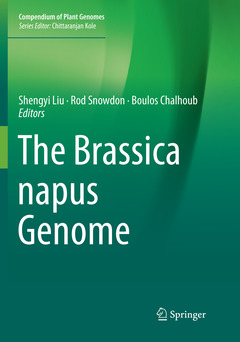Description
The Brassica napus Genome, 1st ed. 2018
Compendium of Plant Genomes Series
Coordinators: Liu Shengyi, Snowdon Rod, Chalhoub Boulos
Language: English
Subjects for The Brassica napus Genome:
The Brassica napus Genome
Publication date: 12-2018
Support: Print on demand
Publication date: 12-2018
Support: Print on demand
The Brassica napus Genome
Publication date: 11-2018
Support: Print on demand
Publication date: 11-2018
Support: Print on demand
Description
/li>Contents
/li>Comment
/li>
This book describes how the genome sequence contributes to our understanding of allopolyploidisation and the genome evolution, genetic diversity, complex trait regulation and knowledge-based breeding of this important crop. Numerous examples demonstrate how widespread homoeologous genome rearrangements and exchanges have moulded structural genome diversity following a severe polyploidy bottleneck. The allopolyploid crop species Brassica napus has the most highly duplicated plant genome to be assembled to date, with the largest number of annotated genes.
Examples are provided for use of the genome sequence to identify and capture diversity for important agronomic traits, including seed quality and disease resistance. The increased potential for detailed ge
ne discovery using high-density genetic mapping, quantitative genetics and transcriptomic analyses is described in the context of genome availability and illustrated with recent examples. Intimate knowledge of the highly-duplicated gene space, on the one hand, and the repeat landscape on the other, particularly in comparison to the two diploid progenitor genomes, provide a fundamental basis for new insights into the regulatory mechanisms that are coupled with selection for polyploid success and crop evolution. Economic/Academic importance.- Cytology.- Background of the sequencing initiatives and genome sequence delivery.- Genetic map, QTLs, association study and genes cloning.- Deciphering genome organization of the B. napus polyploid (including genome assembling and annotation).- TE.- Syntenic genes from alpha to triplication and sextuplication.- Homoeologous Exchanges and Gene loss generate diversity and differentiate the B. napus genome from that of its ancestors.- Epigenomics and Alternative splicing.- Asymmetrical evolution.
Offers up-to-date insights into the latest progress in genome sequencing and analysis Demonstrates how scientific results in plant genomics can be used to improve plant breeding Includes contributions of an international board of authors
© 2024 LAVOISIER S.A.S.




